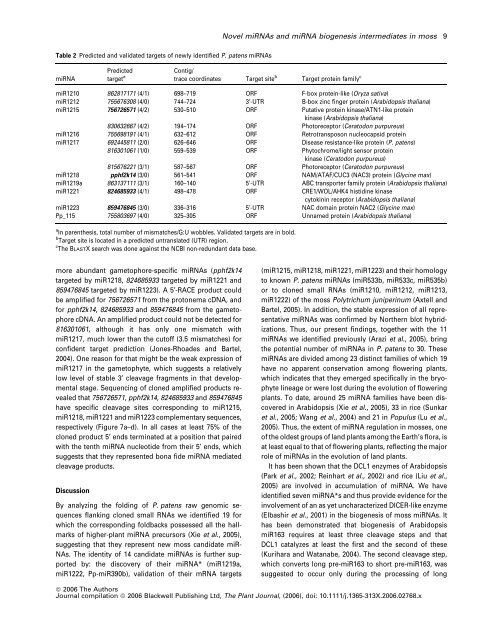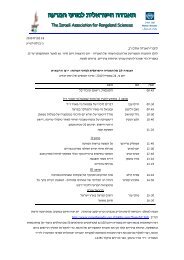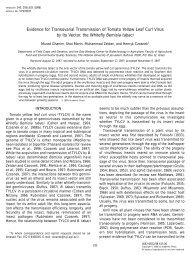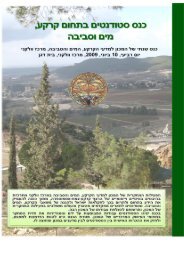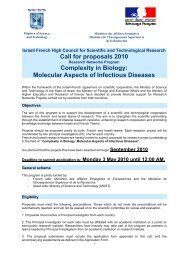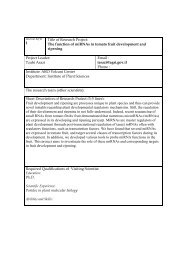Novel micro-RNAs and intermediates of micro-RNA biogenesis from ...
Novel micro-RNAs and intermediates of micro-RNA biogenesis from ...
Novel micro-RNAs and intermediates of micro-RNA biogenesis from ...
You also want an ePaper? Increase the reach of your titles
YUMPU automatically turns print PDFs into web optimized ePapers that Google loves.
<strong>Novel</strong> mi<strong><strong>RNA</strong>s</strong> <strong>and</strong> mi<strong>RNA</strong> <strong>biogenesis</strong> <strong>intermediates</strong> in moss 9Table 2 Predicted <strong>and</strong> validated targets <strong>of</strong> newly identified P. patens mi<strong><strong>RNA</strong>s</strong>mi<strong>RNA</strong>Predictedtarget aContig/trace coordinates Target site b Target protein family cmiR1210 862817171 (4/1) 698–719 ORF F-box protein-like (Oryza sativa)miR1212 755676308 (4/0) 744–724 3¢-UTR B-box zinc finger protein (Arabidopsis thaliana)miR1215 756726571 (4/2) 530–510 ORF Putative protein kinase/ATN1-like proteinkinase (Arabidopsis thaliana)830632667 (4/2) 194–174 ORF Photoreceptor (Ceratodon purpureus)miR1216 755698191 (4/1) 632–612 ORF Retrotransposon nucleocapsid proteinmiR1217 692445811 (2/0) 626–646 ORF Disease resistance-like protein (P. patens)816301061 (1/0) 559–539 ORF Phytochrome/light sensor proteinkinase (Ceratodon purpureus)815676221 (3/1) 587–567 ORF Photoreceptor (Ceratodon purpureus)miR1218 pphf2k14 (3/0) 561–541 ORF NAM/ATAF/CUC3 (NAC3) protein (Glycine max)miR1219a 863137111 (3/1) 160–140 5¢-UTR ABC transporter family protein (Arabidopsis thaliana)miR1221 824685933 (4/1) 498–478 ORF CRE1/WOL/AHK4 histidine kinasecytokinin receptor (Arabidopsis thaliana)miR1223 859476845 (3/0) 336–316 5¢-UTR NAC domain protein NAC2 (Glycine max)Pp_115 755803697 (4/0) 325–305 ORF Unnamed protein (Arabidopsis thaliana)a In parenthesis, total number <strong>of</strong> mismatches/G:U wobbles. Validated targets are in bold.b Target site is located in a predicted untranslated (UTR) region.c The BLASTX search was done against the NCBI non-redundant data base.more abundant gametophore-specific mi<strong><strong>RNA</strong>s</strong> (pphf2k14targeted by miR1218, 824685933 targeted by miR1221 <strong>and</strong>859476845 targeted by miR1223). A 5¢-RACE product couldbe amplified for 756726571 <strong>from</strong> the protonema cDNA, <strong>and</strong>for pphf2k14, 824685933 <strong>and</strong> 859476845 <strong>from</strong> the gametophorecDNA. An amplified product could not be detected for816301061, although it has only one mismatch withmiR1217, much lower than the cut<strong>of</strong>f (3.5 mismatches) forconfident target prediction (Jones-Rhoades <strong>and</strong> Bartel,2004). One reason for that might be the weak expression <strong>of</strong>miR1217 in the gametophyte, which suggests a relativelylow level <strong>of</strong> stable 3¢ cleavage fragments in that developmentalstage. Sequencing <strong>of</strong> cloned amplified products revealedthat 756726571, pphf2k14, 824685933 <strong>and</strong> 859476845have specific cleavage sites corresponding to miR1215,miR1218, miR1221 <strong>and</strong> miR1223 complementary sequences,respectively (Figure 7a–d). In all cases at least 75% <strong>of</strong> thecloned product 5¢ ends terminated at a position that pairedwith the tenth mi<strong>RNA</strong> nucleotide <strong>from</strong> their 5¢ ends, whichsuggests that they represented bona fide mi<strong>RNA</strong> mediatedcleavage products.DiscussionBy analyzing the folding <strong>of</strong> P. patens raw genomic sequencesflanking cloned small <strong><strong>RNA</strong>s</strong> we identified 19 forwhich the corresponding foldbacks possessed all the hallmarks<strong>of</strong> higher-plant mi<strong>RNA</strong> precursors (Xie et al., 2005),suggesting that they represent new moss c<strong>and</strong>idate miR-NAs. The identity <strong>of</strong> 14 c<strong>and</strong>idate mi<strong><strong>RNA</strong>s</strong> is further supportedby: the discovery <strong>of</strong> their mi<strong>RNA</strong>* (miR1219a,miR1222, Pp-miR390b), validation <strong>of</strong> their m<strong>RNA</strong> targets(miR1215, miR1218, miR1221, miR1223) <strong>and</strong> their homologyto known P. patens mi<strong><strong>RNA</strong>s</strong> (miR533b, miR533c, miR535b)or to cloned small <strong><strong>RNA</strong>s</strong> (miR1210, miR1212, miR1213,miR1222) <strong>of</strong> the moss Polytrichum juniperinum (Axtell <strong>and</strong>Bartel, 2005). In addition, the stable expression <strong>of</strong> all representativemi<strong><strong>RNA</strong>s</strong> was confirmed by Northern blot hybridizations.Thus, our present findings, together with the 11mi<strong><strong>RNA</strong>s</strong> we identified previously (Arazi et al., 2005), bringthe potential number <strong>of</strong> mi<strong><strong>RNA</strong>s</strong> in P. patens to 30. Thesemi<strong><strong>RNA</strong>s</strong> are divided among 23 distinct families <strong>of</strong> which 19have no apparent conservation among flowering plants,which indicates that they emerged specifically in the bryophytelineage or were lost during the evolution <strong>of</strong> floweringplants. To date, around 25 mi<strong>RNA</strong> families have been discoveredin Arabidopsis (Xie et al., 2005), 33 in rice (Sunkaret al., 2005; Wang et al., 2004) <strong>and</strong> 21 in Populus (Lu et al.,2005). Thus, the extent <strong>of</strong> mi<strong>RNA</strong> regulation in mosses, one<strong>of</strong> the oldest groups <strong>of</strong> l<strong>and</strong> plants among the Earth’s flora, isat least equal to that <strong>of</strong> flowering plants, reflecting the majorrole <strong>of</strong> mi<strong><strong>RNA</strong>s</strong> in the evolution <strong>of</strong> l<strong>and</strong> plants.It has been shown that the DCL1 enzymes <strong>of</strong> Arabidopsis(Park et al., 2002; Reinhart et al., 2002) <strong>and</strong> rice (Liu et al.,2005) are involved in accumulation <strong>of</strong> mi<strong>RNA</strong>. We haveidentified seven mi<strong>RNA</strong>*s <strong>and</strong> thus provide evidence for theinvolvement <strong>of</strong> an as yet uncharacterized DICER-like enzyme(Elbashir et al., 2001) in the <strong>biogenesis</strong> <strong>of</strong> moss mi<strong><strong>RNA</strong>s</strong>. Ithas been demonstrated that <strong>biogenesis</strong> <strong>of</strong> ArabidopsismiR163 requires at least three cleavage steps <strong>and</strong> thatDCL1 catalyzes at least the first <strong>and</strong> the second <strong>of</strong> these(Kurihara <strong>and</strong> Watanabe, 2004). The second cleavage step,which converts long pre-miR163 to short pre-miR163, wassuggested to occur only during the processing <strong>of</strong> longª 2006 The AuthorsJournal compilation ª 2006 Blackwell Publishing Ltd, The Plant Journal, (2006), doi: 10.1111/j.1365-313X.2006.02768.x


